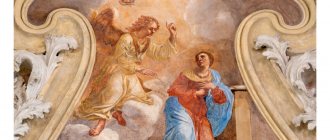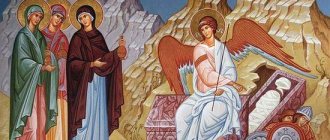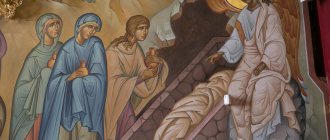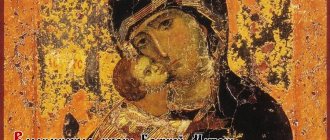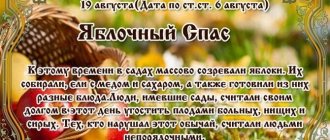The national holiday of the Annunciation is celebrated on April 7 (March 25, old style) every year. In the Orthodox Church this holiday is called the Annunciation of the Blessed Virgin Mary. It refers to the great twelve events of the annual liturgical cycle. The celebration is timed to coincide with the announcement to the Virgin Mary by Archangel Gabriel of the good news about her conception of the Son of God.
Other names of the holiday: Annunciation Day, Annunciation, Salutation to Mary, Spell of Spring, Zimobor, Big Day Holiday and others.
The Annunciation of the Most Holy Theotokos belongs to the great twelve feasts of the Orthodox Church. On this day, believers abstain from work, household chores, quarrels and insults. Parishioners visit churches and make pilgrimages to holy places. This religious holiday is considered the best period for preparing salt, blessed water and prosphora, which will serve as amulets throughout the year.
What date is the feast of the Annunciation of the Blessed Virgin Mary
Modern man, brought up in a society that is mostly far from faith, is often inclined not to see the difference between the dates of secular and church holidays. It seems that a religious holiday is the same “anniversary” of a historical event, like the anniversary of a battle or the founding of a city. However, it is not.
Is the date important?
The earthly life of a person living in time is full of significant moments for him, marking the milestones of existence from “from birth to funeral feast.” For spouses, a special day is another wedding anniversary or even an acquaintance. And then there are the birthdays of children, and later grandchildren. And, of course, everyone remembers their own birthday. There are also many historical dates that are significant for an entire country that remembers its history.
Events of church holidays are different. The essence of all Sacred history is to save people from sin and death. Therefore, the milestones on this path, celebrated by festive services, on the one hand, belong to the earthly world, because they are aimed at helping people, but also relate to Eternity, where the specificity of earthly life with its milestones, dates, anniversaries is not at all significant, but only the very essence of the event.
That is why ancient authors most often indicate its year, but almost never the day and month, as having no spiritual meaning. All this completely relates to the event of the Annunciation - the beginning, or, as the Church sings at the services of the holiday, “the main importance of our salvation.”
Annunciation 2022: coronavirus has made its adjustments
Due to the current situation in the world and in the country related to countering the spread of coronavirus, believers are not recommended to visit churches even on such a great church holiday as the Annunciation of the Blessed Virgin Mary . However, in our time there is a great opportunity to attend a festive service without leaving home. NEVSKIE NEWS launched a series of online broadcasts from the largest churches in St. Petersburg especially for our believing readers during the days of self-isolation.
Today at 09:30 the Divine Liturgy of St. John Chrysostom starts from the Church of the Annunciation of the Blessed Virgin Mary. The service will be conducted by Metropolitan of St. Petersburg and Ladoga Barsanuphius. Watch the live broadcast on the main page of NEVSKY NEWS.
Celebration day
Although images of Mary and the Archangel have been found since at least the 2nd century, the exact date of the celebration appeared much later, from the 4th century. This is April 7 (or March 25 according to the Julian calendar - the “old style” used by the Russian Church). The holiday is celebrated every year on the same day.
I wonder why April 7?
Annunciation of the Blessed Virgin Mary with the Martyr. Theodore Tyrone
When determining the date of the celebration, the Church tried to connect the temporal with the eternal, the heavenly with the earthly, which was fully consistent with the essence of the event. Historically, its day is not known, but the celebration is still established in accordance with the realities of human life: the Annunciation (and the Incarnation) occur exactly 9 months before the Birth of the Savior (January 7), fully human, having spent the usual 9 months in the womb of the Mother.
But the Incarnate One is also God, so from ancient times church authors understood this date in a special way, relating it symbolically and mystically:
- with the creation of the world, April 7 was the first of the days of creation;
- with the creation of man; one of the writings attributed to St. Athanasius of Alexandria (IV century) calls April 7 the day of the creation of Adam; therefore Christ - the new Adam - chooses him for the Incarnation;
- with the Crucifixion of the Lord; based on works of the 3rd century. April 7 is the day of His death on the cross;
- and from the 5th century. the date began to be considered the historical day of the Resurrection, and not the Crucifixion. Thus, April 7 brought together all the key events of history - the creation of the world and man, the Incarnation, and Easter.
Interesting fact
Modern church historians say that by the 10th century. the conviction that both the Annunciation and the Resurrection took place on April 7 became universal, especially in Byzantium. Therefore, here the holiday was even called “Kyriopascha”, or “dominant” Easter, that is, “real”, historical, the church year began with it. Many Western Christian communities counted the new year in the same way.
Signs and sayings
- As you spend the Annunciation, you will live for the whole year.
- Veil is not summer, Annunciation is not winter.
- As is the Annunciation, so is the bright week.
- Frosts on the Annunciation foretell a rich harvest.
- If it rains on Annunciation Day, then there will be a good harvest of rye, but if there is a thunderstorm, nuts will be born.
- If a chicken lays an egg on this day, then as a rule it will be empty, that is, empty, and a chicken will not hatch from it.
- If swallows have not arrived by April 7, then spring will be cold and late.
- On Annunciation, you must eat prosphora to make the year successful. If you bury a piece of prosphora in the garden, the soil will yield a rich harvest.
- If you manage to steal something on this day, then the next year will be successful and prosperous.
- If you buy new clothes the day before or on the day of a holiday, then under no circumstances should you try them on on that day, otherwise they will quickly deteriorate and tear.
- If a wife calls her husband “beloved” forty times on this day, then love and peace will await the family for many years.
- The wish that will be made for the Annunciation will soon come true.
- Those born on April 7 should wear agate.
Can the celebration coincide with Easter, when has this happened?
Nowadays the word “Kyriopascha” has a completely different meaning: it is a combination of calendar dates for the celebration of the Resurrection of Christ and the Annunciation. The Easter holiday is the so-called “moving” holiday, so it is celebrated on Sunday after the first full moon has passed from the day of the vernal equinox (March 21). Moreover, if it falls before the Jewish Passover or coincides with it, then, according to the decisions of the First Ecumenical Council, it moves forward a week. Therefore, the timing of Easter celebrations changes from year to year. Sometimes it and the Annunciation can actually coincide.
The so-called Alexandrian Paschal, which is followed by the Eastern Churches, gives such a coincidence 12 times in the so-called “Great Indiction” of 532 years, or several times per century. However, not every coincidence was called “Kyriopaskha” by a number of Eastern fathers. For example, the Byzantine writer Matthew Blastarus says that the “true” Passover is the one that falls on the day after the Jewish Passover, which happens less than once a century.
During 20th century, Kyriopascha happened twice: these were the simultaneous celebrations of the Resurrection and Annunciation in 1912, and also in 1991. The closest coincidence of dates is in the 21st century. will happen in 2075, then 2086.
There are some kinds of superstitions about Kyriopascha that have arisen over the past decades. They are associated with popular ideas that the coincidence of the Resurrection and the Annunciation is supposedly a sign of special disasters awaiting people. Perhaps such ideas are the “fruit” of the so-called “dashing 90s,” when on the eve of the collapse of the USSR, Easter and the Annunciation actually coincided. Such ideas, however, are contrary to the very spirit of both holidays, which are associated with God’s special mercy to people, and not with their punishment, and in addition, they have absolutely no support for the ancient tradition, which considered “Kyriopascha” “true”, “real”.
Could it be after Easter?
This situation is possible. According to the Alexandrian Paschal and the Julian calendar, which the Russian Church and many others rely on, the earliest date for Easter may be April 4, then the Annunciation falls on Bright Week. The last time this happened was in 2010.
Why was the holiday called the Annunciation and what does this word mean?
The essence of the event is described in detail only by one of the four Evangelists, Luke. It is his words that are solemnly read by the deacon during the liturgy of the holiday:
“... the angel Gabriel was sent from God to the city of Galilee, called Nazareth, to a virgin betrothed to a husband named Joseph, from the house of David; The name of the Virgin is Mary...” (Luke 1:26-27).
The heavenly messenger came to the Virgin with the joyful (good - hence the name of the holiday) news that She was God’s Chosen One, destined to be the Mother of the Savior. But it is not the incomprehensibly completed Incarnation of the Lord (the mystery of which is revealed neither by the Evangelist nor by Tradition) that the celebration is dedicated to. Its center is the Good News itself, in Greek “Εὐαγγελισμός” (“Evangelios”). Why?
The words of the Archangel “You will conceive in your womb and give birth to a Son, and you will call His name Jesus. He will be great and will be called the Son of the Most High…” demonstrate the will of God, which, however, awaits the voluntary consent of the future Mother of the Savior. For the salvation of people cannot be achieved without their own will. Then Mary utters perhaps the most important words in the centuries-old history of mankind: “Behold the servant of the Lord, be unto me according to thy word.”
The fact that among people there was a Virgin who spoke these simple words to the Lord, who accepted with her heart everything that followed them - persecution, the terrible pain of the Crucifixion of the innocent Son, His terrible death - all this is much more important than the mysticism of the coming of the Son of God.
Interesting fact
The holiday is “good news” at the same time about the mercy of God, and about the fact that people entangled in the networks of sin are not hopeless, since Mary was found among them.
Christians did not immediately form such an understanding of the event. The well-known name appeared and began to be used regularly from the 7th century. Before this, there are such names as “Day of Greetings”, “Feast of the Incarnation”, “Beginning of Redemption”.
What you can do for the holiday, how to spend it correctly
Iconography: Annunciation of the Blessed Virgin Mary Dates: XII century. 30-40s of the 12th century. Icon painting school or art center: Novgorod school Origin: From the St. George Cathedral of the Yuriev Monastery in Novgorod, from where it was brought, among other icons, by Ivan the Terrible to the Assumption Cathedral of the Moscow Kremlin. Material: Wood, tempera. Dimensions of the icon: height 238 cm, width 168 cm. The Mother of God is depicted standing, with her head slightly tilted to the left. Christ Emmanuel is depicted in her womb. He is presented frontally, sitting in a solemn pose, with his right hand in blessing, his left hand held to the side (the hand has not been preserved). The Mother of God, as it were, overshadows him with her right hand, the fingers of which almost touch the Child’s shoulder and touch the halo. In her left hand is a skein of red yarn. On the left is the Archangel Gabriel, facing Mary and blessing her. In his left hand he holds a measure. At the top, in the center, in a blue semicircle of the sky with golden stars, the “Ancient of Days” is represented sitting on a red throne. At the foot of the throne are red cherubs; a little higher, on the right and left, are red seraphim with golden ripids. Around the "Ancient of Days" is blue glory. In his left hand is a scroll, his right hand is a blessing, and from it a blue ray goes to the figure of the Mother of God. Inv. No. 25539 © State Tretyakov Gallery, Moscow Literature: State Tretyakov Gallery. Collection catalogue. Old Russian art of the 10th - early 15th centuries. Volume I. No. 7.
Russian folk tradition has long maintained a reverent attitude towards the Annunciation, which was sometimes placed even higher than Easter.
Interesting fact
Russian ethnographers of the early 20th century. a story told by peasants in one of the localities of Central Russia is recorded. Once, when the Annunciation coincided with Easter, the priests forgot about the holiday and served the night Easter service without the Annunciation chants. But at the end of the liturgy, it turned out that the sun never rose. Only a few hours later they guessed the reason: with the beginning of the hymns of the Annunciation, the world became brighter. But it turned out that the sun was already in the west. So it did not want to illuminate the earth that day.
This story, whether it is true or legend, shows the attitude of the people towards the holiday. The peasants were not having fun, especially since the holiday, as a rule, fell during Lent. The main activity was attending worship services and eating a modest meal.
Modern pastors, without departing from ancient traditions, advise, if possible, to celebrate the Annunciation by participating in church services. This:
- all-night vigil the night before;
- Liturgy directly on the day of celebration.
As far as possible, it is better to prepare for the Sacrament of Communion with intense fasting and confession. However, it often happens that the celebration falls on a weekday, when most people do not have the opportunity to leave work.
A special situation arose in 2022, when, due to the pandemic, believers were not allowed into most churches. Then, on the Internet pages of many churches, even the Moscow Patriarchate, texts of divine services in the secular rite appeared, with the omission of deaconal exclamations and priestly prayers. It is quite possible to pray in this way if it is impossible to come to the service. In addition, there are also Canons, Akathists for the Annunciation, which can also be read at home.
And here’s how Archpriest Andrei Tkachev advises spending the day preaching on April 7, 2012:
“A worthy admirer of the Annunciation must from time to time immerse himself in reading the Word of God and concentrate on what he read, as the Blessed One among Women was in the habit of doing.
One of the goals of a devotee of the Mother of God should be the desire for a life that is quiet and removed from the bustle, but at the same time internally rich and deep.
Conditions of existence may not give a person such a gift, and he himself may be incapable of long-term concentrated living. But every person, raising his eyes to heaven and repeating Gabriel’s words: “Rejoice, full of grace, the Lord is with you,” is obliged to strive for silence and prayer, to sigh from time to time about their absence.
What to prepare for this day
As for the festive table, it is, as a rule, very modest. If the holiday falls on the days of Lent, the Charter allows fish food. However, during Holy Week, it is customary to abstain from it, as well as from vegetable oil, but a small amount of wine is allowed for the sake of the great event. If the Annunciation is celebrated after Easter, there is, of course, no fasting.
Traditions and customs of the church holiday
According to popular belief, on the eve of this day, a dream in which you can see a full well or any other water source is a lucky sign. Such a dream predicts not only good luck in life, but also prophesies to a recently married woman the birth of her first child.
In the good old days, there was a tradition of releasing birds from the cages in which they were kept on the Annunciation. A similar action could be seen in many churches. They say that the custom has been resumed since 1995, and the pigeons are being released into the wild in 2021.
You can also mention an ancient custom - the preparation of prosphora, which is received at the end of the church service dedicated to the day of the Annunciation. It is a Lenten baked product prepared by clergy as a symbol of spirituality.
Many parishioners take the prosphora home to distribute to loved ones. Quite often, prosphora is served to sick people so that they can quickly regain strength and recover. It is worth noting that the remains of this treat should not be thrown away; it is better to add them to pet food.
It is worth mentioning that in rural areas the holiday characterizes the arrival of spring, which comes into its own, which makes it possible to begin preparing seeds for planting. Quite often, villagers bring grain to the icon of the Mother of God. It is believed that this allows the grains to absorb favorable energy, which will affect the future harvest.
The customs for Annunciation 2022 can be compared with the traditions of celebrating Ivan Kupala Day, when those who wish also make a fire, jump over a fire and dance in circles. These rituals encourage spring to come as soon as possible.
A woman who prays to the icon of the Virgin Mary on this day can mention her innermost request. Most often, it is associated with the desire to send her a good groom, the birth of a child, or recovery for a close relative.
They say that on the land where the Archangel Gabriel pleased Mary with the good news, there is a well. Anyone who wants to express their deepest desire can approach him.
Annunciation 2022 is accompanied by a religious procession, before the start of which you should start collecting your Easter basket. Also on Saturday, it is recommended to decorate the home with branches and fresh flowers, which should symbolize the beginning of a new life.
In addition, believers take blessed water from temples, which remains after the celebration. It is believed that it retains life-giving power throughout the year, and that such water can raise even seriously ill people to their feet.
However, consecrated water could lose its qualities if a person with an evil eye drew attention to it.
Protective amulet
The Annunciation is a great time to make a talisman for the whole year. A home amulet will protect your home from evil and bring only happiness and prosperity. Without dried herbs, horseshoes and amulet, housing in the old days was considered unprotected. Charms are part of folk traditions, serve as protection against negative forces and diseases, and to protect marriage.
To create your protector, collect willow branches, they should be cut to the same length. The branches are tied on one side with red and green floss threads (for embroidery) and a small broom is formed. When making a home amulet, you need to think about the good, imagine the well-being of the family, prosperity, and good luck.
Bags of herbs are attached to the amulet, decorated with dried flowers, and pins are also hung. The broom-amulet is hung with a bunch to the bottom and branches to the top, as if we were going to sweep the ceiling.
What not to do on holiday
Among the folk traditions of the holiday, there are many that go back to paganism or those that are no longer practical to follow, and sometimes impossible. Among them:
- a well-known tradition of abstaining from any work that existed among the peasants: “On Annunciation, the bird does not build a nest, the maiden does not braid her hair”; the Church Charter, of course, does not bless work during holidays instead of worship; however, a Christian living in a secular state is often simply forced to go to work, especially when a holiday falls on a weekday; It should be remembered that it is not work in itself that is sinful, but immersion in worldly vanity, which does not allow one to feel the holiday and experience it;
- sometimes you can find a superstition associated with another prohibition - the use of fire; Russian peasants believed that a trespasser could be killed by lightning in the summer; Of course, such a prohibition has nothing to do with the holiday, or with Christianity in general;
- various kinds of semi-pagan rituals of the “cry of spring”, which were often performed by peasants of the 19th century, and are now sometimes practiced by neo-pagans.
“Our salvation is the main thing” - a great, holy day. At this (as, indeed, at any other) time it is prohibited:
- “bite and eat” your neighbors with condemnation and anger;
- indulge in immoderate entertainment, gluttony, drunkenness;
- generally do things contrary to God’s commandments.
How the Annunciation was celebrated
In all centuries, the Annunciation has been considered the most important Christian holiday. In honor of this event, special ceremonial services were held (and are still taking place) in churches. The people, of course, brought their own folklore notes to this great date. This refers to all sorts of signs, beliefs and hopes and hopes associated with them.
Firstly, since the Annunciation is celebrated in April, it was associated with the onset of spring, when nature awakened.
- The people claimed that on the Annunciation, birds begin to return from warmer climes to their native nests.
- On the day of the Annunciation, all kinds of animals that were in hibernation awaken and come out of their holes and dens: bears, hedgehogs, badgers, etc.
- On Annunciation, insects also awaken from a long winter hibernation. Therefore, on the eve of this day, the owners took out the hives with bees.
- There was a wonderful custom of releasing birds into the wild on Annunciation Day. People went en masse to the markets, bought birds there and opened the cage doors. Fly, birds!
- It was believed that before the Annunciation no earthwork could be carried out - neither plowing nor digging.
- On the Annunciation (since it was believed that spring had come), young people happily burned their old winter beds and moved to spend the night in haylofts and other free places.
- It was strictly forbidden to work at the Annunciation. There were even special proverbs about this. For example: “On Annunciation Day, no bird builds a nest.” Or: “On Annunciation, the devils in hell do not torment sinners.”
There were also special Annunciation signs, which, it must be said, always came true with amazing accuracy. Here are just a few of them.
- Ice drift begins either a week before the Annunciation, or exactly a week after it.
- If spring began before the Annunciation, it means there will still be frosts ahead.
- On Easter the weather will be the same as on Annunciation.
- If the night before the Annunciation is warm and quiet, then the whole spring will be the same.
- If there is fog on the morning of Annunciation, you should expect large floods.
- If it is cloudless and warm on Annunciation Day, it means that the summer will be hot, dry and fire hazardous.
- If frost hits on Annunciation, you should expect a good harvest of oats, and if it rains, then rye will grow.
And yet, early on the Annunciation morning, people met the sunrise. They say that on this holiday morning the sun rises in a special way; it seems to be “playing.” And everyone who sees this beauty will live happily ever after. Let's wait for the Annunciation and watch the sunrise! After all, Annunciation signs, as you know, come true.
Watch this video about the history of the Feast of the Annunciation:
How to congratulate loved ones
Since ancient times, the best congratulation for the holiday was its troparion, which perfectly conveys its content, meaning, as well as the joy of the Incarnation of Christ and the Mother of God, whose humility led the human race to God:
“The day of our salvation is the main thing, and since the beginning of time the mystery has been revealed: the Son of God is the Son of the Virgin, and Gabriel preaches grace. In the same way, we cry out to the Mother of God: Rejoice, full of grace, the Lord is with you.”
In addition, during the holiday, believers try to congratulate each other by phone or in person, with short, warm words.
Invocation of Spring for the Annunciation
One of the most striking traditions of celebrating the Annunciation is Zaklichki or the invocation of spring. This tradition has been preserved since pagan times, but in our time it has acquired a different meaning.
People gathered together, sang funny songs and lit fires. These very fires were popularly called chants. Young people danced around the fires and sang songs calling for spring and warmth. With the advent of Orthodoxy, these songs began to contain appeals to the Lord and the Mother of God, whom people asked for a good harvest.
In stoneflies, songs around fires, people also addressed birds and spring. These songs sounded a little sad, even with an alarming intonation.
For calls, special cookies were often baked from unleavened dough in the shape of larks. These larks were distributed to relatives and given to children, who ran through the streets with larks impaled on sticks and called out for spring.
